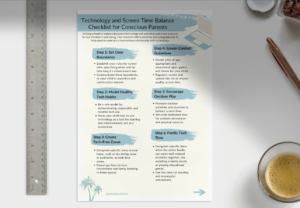It happened; we fell from our healthy screen time boundaries and got lost in arguments where phrases like “I need 10 more minutes” and “You don’t understand these llamas need to spawn” became daily issues.
The cat trauma of Christmas left my 11-year-old daughter in deep grief, so I allowed her to binge-watch Young Sheldon and lose herself in Minecraft. My husband was away, and I was spending hours caring for our nine cats.
Unlike those of you who go “back to school,” we had a slower start back to our learning routines, so screen time lingered a bit after Christmas. Then I suggested we needed to sit down and plan our screen time agreements for 2024. This was met with huge resistance. HUGE!
Screen Time Agreements
She knew that any new agreements were going to feel harsh after this lapse, so she fought it, until suddenly I realised we were in a bickering-over-screen-time cycle. This has NEVER happened before because, in my Positive Discipline training, our life was transformed by agreements. Together, we had agreements for everything. She did not get an iPad until she was 9, a gift I would have rather she did not receive as she is a creative child who can keep herself entertained for hours without the need for a screen (I am very sure because of the lack of presence of screens in the first place).
But now, the agreements were gone…
Today, we made new agreements, so I thought I would walk you through the process and explain how we got there.
In the realm of Positive Discipline, agreements are powerful tools that foster cooperation and understanding between parents and children. Rather than imposing rules unilaterally, Positive Discipline encourages open communication and collaboration.
Agreements are like bridges built on mutual respect, where parents and children come together to discuss expectations and boundaries. These agreements are not just about compliance; they provide a platform for children to express their thoughts and feelings, which in turn helps them develop decision-making skills and a sense of ownership in the family dynamics.
When agreements are reached collectively, children are more likely to honour them, and conflicts are often replaced with a harmonious atmosphere where both parties feel heard and valued. They really are a cornerstone for harmony with my daughter.
If you are concerned about how technology is impacting your child’s life and you are looking for practical guidance to maintain a healthy balance between screen time and other activities, Get Your FREE Technology and Screen Time Balance Checklist for Conscious Parents here.

Working Together for Screen Time Boundaries
So we looked at last year’s screen time agreement, which was:
- 3 hours a week gaming.
- 3.20 hours a week TV time.
Here the kind but firm negotiations began. Online learning is now part of our weekly education.
- Daily Duolingo for Spanish: 10 to 15 minutes a day.
- Word tag: 30 minutes x 3 a week.
- Night Zoo Keeper: 30 minutes x 3 a week.
These items are learning screen time, as are Zoom calls for English and Acting. Then we discussed leisure learning.
I would like to give her 3 hours a week gaming and 3.5 hours TV (we don’t actually own a TV but watching programs on her iPad).
She would like unlimited screen time.
So now, to meet in the middle after discussions about which games she plays, which programs she likes to watch, how long the episodes are, and how much she likes to watch, we finally mutually agreed:
- Gaming: 5 hours a week. ( this includes creating images on Canva which she loves)
- TV time: 4 hours a week.
- Messaging: 1 hour.
I am not happy about messaging, but she uses basic phone messages. There is an agreement: no group chats, and she actually only messages about 8 people, and the agreement is that those messages are available for me to read, plus she has her dad on messages, so it is important that she has access to that.
Our agreement is that if her dad video calls, that does not count as screen time either. Obviously, that will never be limited.
Then we brought in the core foundations.
- NEVER screen them BEFORE 10 am.
- NEVER screen time AFTER 8 pm.
Duolingo: 1.5
Word tag: 1.5
Night zoo keeper: 1.5
Gaming: 5 hours
TV time: 4 hours
Messaging: 1 hour
Acting: 2 hours
English: 1 hour
Family film night: 2 hours
19.5 hours a week, which is just under 3 hours a day. That feels like a lot to me, but we do a lot of education online these days, so that actually accounts for around half the screen time.
How does our screen time compare
According to The Centers for Disease Control and Prevention (CDC), the average daily screen time hours per age group in the US are:
- 6 hours for 8- to 10-year-olds.
- 9 hours for 11- to 14-year-olds.
- 7.5 hours for 15- to 18-year-olds.
I am can’t find the same stats for the UK or Spain but The Independent ” goes on to give us some sobering facts on screen time.
“These figures don’t include the use of screens for educational purposes, either, which suggests the need for a more nuanced understanding of screen time; to get to grips not only with how much time people spend online, but how they’re actually using that time, too.”
There’s one group particularly affected by high screen time – and that’s children. Excessive screen time has long been linked with negative effects on a child’s developing brain – including their attention span, memory, ability to concentrate – and how they behave.
In one EdWeek Research Centre survey in January and February 2022 of almost 900 K-12 educators in the US, 80 per cent reported that increased screen time worsened children’s behaviour. Fourteen per cent said it wasn’t affected, while a mere 6 per cent reported screen time makes children’s behaviour “a little better”.
What’s more, data from the Adolescent Brain Cognitive Development study – the largest long-term study of brain development and child health in the US – has linked screen time with insidious effects on children’s growing brains.
The study found that children who spent more than 2 hours a day on screens scored lower on thinking and language tests. Worse still? Kids with more than 7 hours of daily screen time experienced a thinning of the cortex – the part of the brain responsible for reasoning and critical thinking.
Yet despite the risks of high screen time, and its effects on how young people behave, parents are still giving them plenty. Data from Insider Intelligence suggests most US parents (51 per cent) give their children three or more hours of screen time a day. Conversely, just 15 per cent of parents limit their children to a maximum of an hour on their devices.”
If you are concerned about how technology is impacting your child’s life? And you are looking for practical guidance to maintain a healthy balance between screen time and other activities then. Get Your FREE Technology and Screen Time Balance Checklist for Conscious Parents here.





